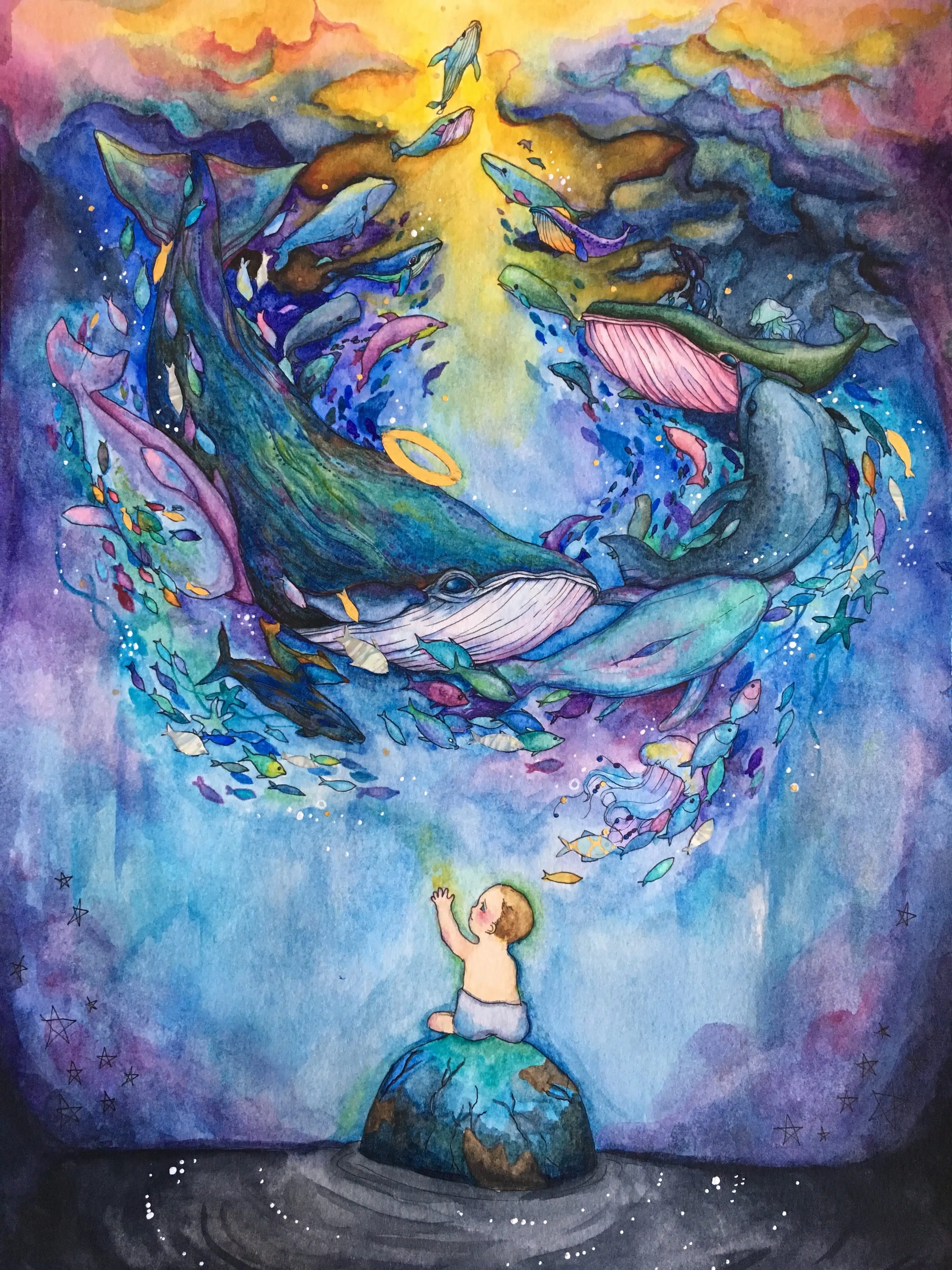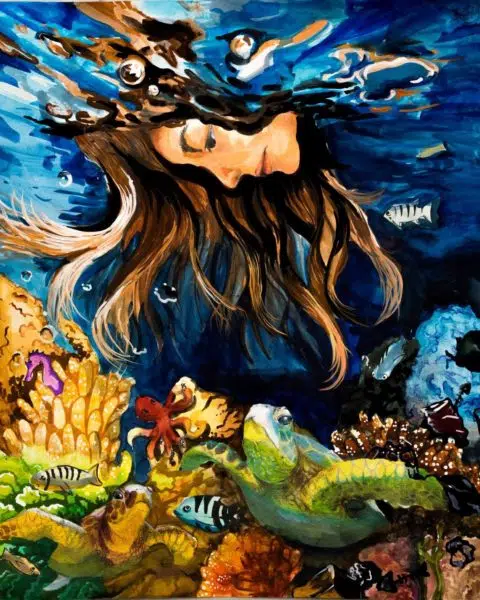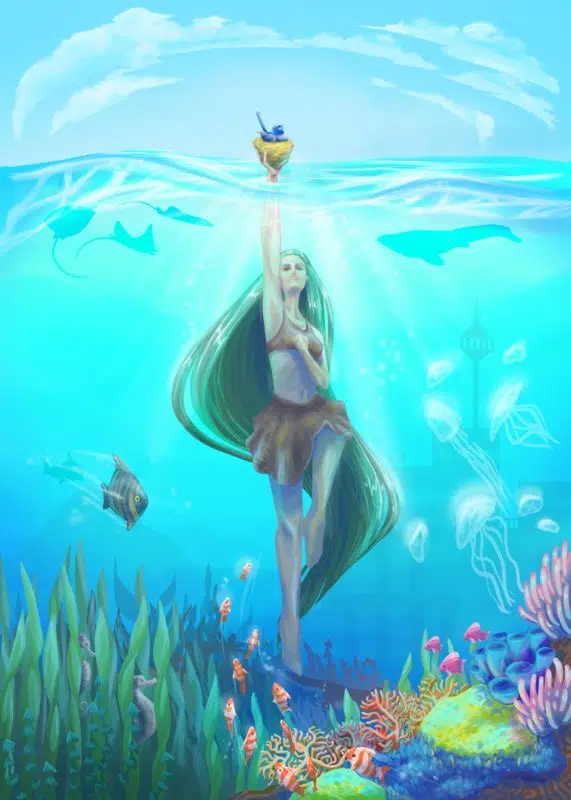Contest Overview
Thanks to everyone who participated in the 2025 Contest, Connections to Nature: Looking Inside, Going Outside! Winners from that Contest will be announced in late November 2025.
2026 Theme | Your Story, Our Ocean: How Our Ocean Sustains, Protects, and Inspires Us
A CREATIVE CHALLENGE FOR TEENS WORLDWIDE
Your Story, Our Ocean Prompt
The 2026 Ocean Awareness Contest – Your Story, Our Ocean – encourages you to explore the many ways our ocean sustains, protects, and inspires us. We invite you to think about your personal connection to the ocean – whether you’re coastal or landlocked – through the value it brings to your life. The benefits of the ocean are widespread and multifaceted, from food production to climate regulation to artistic inspiration. Go through the sub-themes and explore the topics that resonate with you. Share how the ocean has shaped your story through art, writing, performance, film, or multimedia. How does the ocean sustain, protect, and inspire you?
The Contest deadline is June 8, 2026.

A NEW CHALLENGE
The ocean has always been central to Bow Seat’s mission. Since the first Ocean Awareness Contest in 2012, we’ve asked students to explore ocean-related issues like marine species conservation, plastic pollution, and climate change. As our organization continues to evolve in new and exciting ways, we wanted to return to the topic that has captivated, moved, and activated tens of thousands of students who have participated in the Contest: the ocean! What value does the ocean bring to all of our lives? We’ve learned about the challenges that threaten the ocean, but why is it so important that we protect it?
We challenge you to dive into this year’s theme by exploring how the ocean sustains, protects, and inspires you and your community. We hope that these prompts serve as jumping-off points, guiding you toward further exploration! Be sure to check out our past winners and explore our broader Resource Studio for ideas and guidance.
Our Resource Studio is a unique space for creative exploration and a jumping-off point for deep inquiry of climate change, ocean conservation, and using art and creativity as tools in environmental movements.

From the fish sustaining coastal communities to medicines derived from jellyfish, the ocean feeds us and provides us with materials integral to countless lives. We create glass from sand, extract ingredients from algae to thicken foods like ice cream, and harvest pearls from oysters. Beyond these physical resources, the ocean produces over half of the oxygen we breathe and helps drive the water cycle by fueling evaporation and rainfall. It sustains our lives through natural processes that are not only practical and economic, but also deeply connected to our cultures and survival. What are some meaningful or unexpected ways the ocean provides for you or your community? In what ways does the ocean provide beyond physical resources—such as emotionally, spiritually, or culturally?
But while the ocean sustains us, it also relies on us to sustain and protect it in return. Reciprocity, a concept deeply rooted in the worldviews of many Indigenous cultures worldwide, emphasizes a balanced, respectful relationship between humans and the natural world. Through this view, accepting the ocean’s sustenance is not a one-way transaction but an obligatory action that comes with giving back, whether through acts of stewardship or restraint in regards to resource use. This sub-theme invites you to explore what it means to be sustained by the ocean and ensure that it can nourish life for generations to come. What local traditions, practices, or stories reflect a reciprocal relationship with the ocean? What might a reciprocal relationship look like? What barriers—social, political, or economic—stand in the way of true reciprocity with the ocean, and how might they be challenged?
Just as the ocean plays a protective role by shaping coastal terrain to mitigate storm damage, it also serves as a climate buffer, acting as a carbon sink and absorbing heat. Mangroves prevent erosion of our coasts and protect us from natural disasters such as hurricanes and storm surges. The ocean itself acts as a carbon sink, absorbing about a quarter of the carbon dioxide we emit and helping to regulate the Earth’s climate by reducing the severity of global warming. Yet as it absorbs CO2, it acidifies, harming wildlife, and as it absorbs heat, countless species must alter migrational pathways. How can we better prepare for natural disasters by working with, not against, nature? In what ways do natural disasters reveal environmental injustice or unequal vulnerability?
While the ocean does so much to protect us from natural disasters, and even from ourselves, there is a limit to how much it can take before the balance shifts in a dangerous direction. Just as it protects us, we must also protect it in return, maintaining the delicate balance it has upheld for so long. Protecting the environment isn’t just about preserving beauty. It’s about ensuring stability, resilience, and survival in an age of rapid change. This sub-theme invites you to explore how natural systems protect us and the reciprocity of this relationship. Which environments around you act as buffers to environmental change? Are they protected? What would the world look like without these buffers? What can we do to prevent that future?
From the hydrodynamic hulls of ancient boats, shaped to mimic the forms of darting fish, to the tales of sea gods preserved by myth, the ocean has long been our source of awe and creativity. It has served as the stage for legends like Homer’s Odyssey, inspired the haunting sea ballads of coastal communities, and shaped the settings of iconic films such as The Little Mermaid and art like The Great Wave off Kanagawa. It has even shaped our understanding of technology through biomimicry, with seashells exhibiting the golden ratio in the angle of their spirals and sponges serving as inspiration for sturdy architecture. What technological advances do we owe to the ocean? Is there a specific ocean species that you find brilliantly designed—something that humans could learn from or replicate?
The ocean’s influence is carved into pottery dating back centuries and engraved in indigenous knowledge and histories. Just as we did then, we still love to create. But the wellbeing of the ocean, our ancient muse, is not as it once was. As pollution, warming, acidification, and much more pressure this massive ecosystem and the life within it, it is crucial to remember its importance to our many communities.
With the many gifts of the ocean comes the question, “what would we do without it?” Just how deeply is the ocean ingrained in our joys, hopes, and successes? This subtheme invites you to explore the ways the natural world inspires you and the world you live in, as well as the importance of what we stand to lose. Reflect on the ocean influences you see around you and what they mean for your community and beyond. What are some of the earliest ocean-related films, books, or songs that resonate with you and why? How do they shape your perception of the ocean? What might be lost culturally if younger generations grow up without ocean stories or influences? If some of your favorite ocean-related characters were real, how do you think they’d react to the state of the oceans today?

Who May Enter
Students ages 11-18 from around the world are invited to participate in the Ocean Awareness Contest. Enter the division based on your age at the time of entry:
- Junior Division: Age 11-14
- Senior Division: Age 15-18
Students can participate as an individual or as a club, class, or group of any size. All students must provide the contact information for an Adult Sponsor (teacher, parent, mentor, etc.) Students who have started college or university are not eligible to participate in the Contest.

Submissions are accepted in:
- Visual Art: Handcrafted
- Visual Art: Digital
- Poetry & Spoken Word
- Creative Writing
- Film
- Performing Arts: Music & Dance
- Interactive & Multimedia
Please review all submission requirements carefully.
CONTEST DEADLINE: JUNE 8, 2026
How to Enter
Why participate?
- Join Bow Seat’s global movement of over 42,000 young creatives who care about the ocean, environmental justice, and climate action, and contribute to the largest youth environmental arts collection in the world.
- Gain knowledge about environmental issues, nature, and your relationship with the world around you. Dive into Bow Seat’s Resource Studio to learn more about the issues; find artists and organizations taking action to protect our blue planet; and discover ways that you can get involved.
- Grow your skills in communication, critical thinking, creativity, and environmental advocacy. Use your artwork to raise awareness for critical environmental issues.
- Build your portfolio and make art in your preferred medium, or practice a new one! Add to your resume with a participation certificate.
- Showcase your talents worldwide. Through art exhibitions, publications, social media campaigns, and scholarships, Bow Seat uplifts diverse youth voices to advance dialogue and participation in environmental conservation and advocacy.
- Be eligible for special opportunities, like the Future Blue Youth Council. Past program participants also serve as Bow Seat interns and Contest judges!
- Earn cash awards of up to $1,000!
